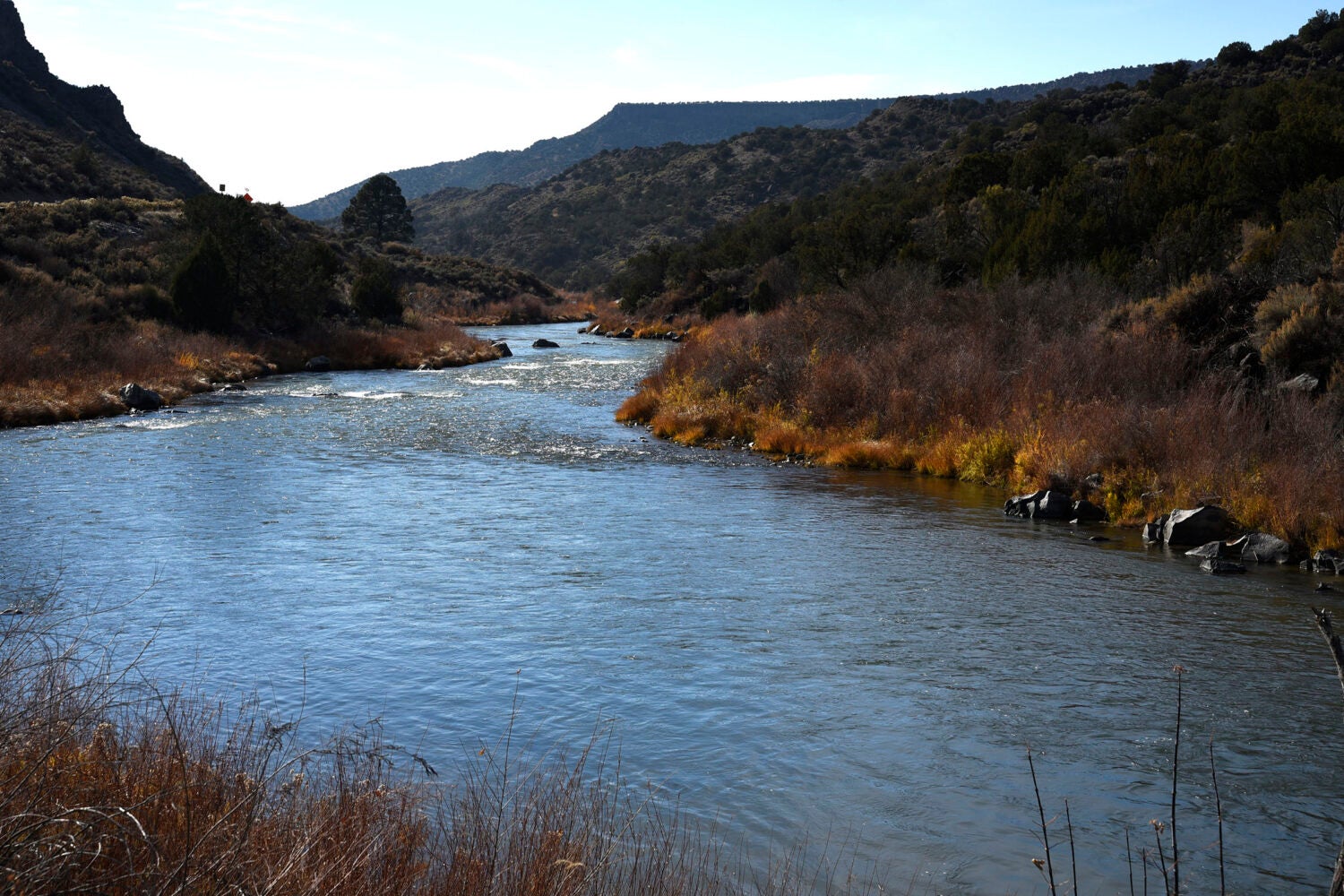Can Texas, New Mexico, and Colorado agree to a new apportionment of the Rio Grande’s waters without the U.S. government’s approval?
The Supreme Court of the United States is set to hear a case next week that may affect access to water for millions of Americans — and set a precedent that could impact millions more, as increased usage and climate change further strain supply of the precious resource.
On March 20, the Court will consider Texas v. New Mexico and Colorado, a tangled case involving water rights to the Rio Grande, a 1,896-mile river that begins at the base of the San Juan Mountains and runs into the Gulf of Mexico. The case, which has been in litigation for more than a decade, centers around a 1939 compact between the three states over how to apportion the river’s waters. In its initial lawsuit, Texas claimed that New Mexico violated the longstanding agreement by not allowing enough water to flow to the Lone Star State, says Andrew Mergen, the Emmett Visiting Assistant Clinical Professor of Law in Environmental Law at Harvard.
But the affected states are not the only ones with rights to the Rio Grande’s waters — several Native American tribes and the U.S. government have interests as well, adds Mergen. In fact, the case has already landed at the Supreme Court once before. In 2018, all nine justices voted to allow the federal government to intervene in the suit.
Since that decision, Texas, New Mexico, and Colorado have come to an accord. But now, the U.S. government says that the suit cannot be settled without its approval.
In an interview with Harvard Law Today, Mergen, who is also the faculty director of the Emmett Environmental Law and Policy Clinic, helps demystify the lawsuit, explains why the federal government intervened — and why this is an important case to watch.

Harvard Law Today: What is the Rio Grande Compact?
Mergen: It’s an apportionment compact. This is an interstate river system, and what the compact does is apportion water between the states. It was agreed upon in 1939, which was a period of time when agricultural interests were developing and there was a greater need to apportion waters between states. There are three states that are parties to it: Colorado, New Mexico, and Texas. But significantly, there is also a treaty obligation on the part of the United States to deliver a quantity of the river’s water to Mexico. And the other thing that’s significant about this particular compact is that, as part of its terms, it also acknowledges the duty to Indian tribes, who also have an interest in this water.
HLT: What is this lawsuit about, at its core?
Mergen: This case was brought by Texas against New Mexico, and it arises in a particular context. When the apportionment was made in 1939 between the states, there wasn’t as much groundwater pumping as there is now. Starting in the 1950s, there started to be more groundwater pumping. Because of the connection between groundwater and surface water, that increased groundwater pumping diminished the amount of surface water getting to Texas and prompted this lawsuit over a decade ago.
HLT: Were there any other flaws in the original agreement?
Mergen: There is this huge problem in western water in general, including with the Colorado River Compact, which is that the baseline usage involves an unrealistic amount of water. We see increased climate change and groundwater pumping, which deplete surface flows. And so, the baseline from when this compact was enacted in 1939 has undoubtedly changed, but we’re locked in. That’s what makes it so difficult.
HLT: This case has already made its way to the Supreme Court once, in 2018, when the federal government sought to intervene. Why did the U.S. want to get involved in this controversy?
Mergen: One reason the U.S. has a strong interest in this case is because of its obligations to Mexico. Another reason is that this water is delivered in part through a reclamation project. The Bureau of Reclamation is an agency within the Department of the Interior, whose major function is to deliver water to irrigators in the arid est. The government’s role in managing and delivering this water through the Elephant Butte Reservoir vests the government in this river system. The bureau operates the project sort of like plumbing system: we plumb the river, and we create “bathtubs” so that we can store water to release at the appropriate time.
Thirdly, the federal government, and the Department of Interior in particular, has an obligation to Indian tribes, who have an interest in that water.
Given all that, at some point in the suit, New Mexico said that the U.S. needed to be a party to this case, and the U.S. moved to become a party.
“We’re already seeing that, because of the changing climate, we are having more issues with freshwater availability and scarcity.”
HLT: What did the Supreme Court say about whether the U.S. could intervene?
Mergen: In a unanimous decision by Justice Neil Gorsuch, the Court said that the government should be a party in the case. It was careful to say, “We don’t think this is the rule in every compact dispute. But on the basis of the facts of this case, the government should be a party.”
HLT: After that decision, the states eventually came to an agreement. So, what is the Court going to consider next week?
Mergen: The controversy that will be heard later this month relates to whether Texas, New Mexico, and Colorado can enter into a settlement — a consent decree — without the U.S. consenting to the settlement. The U.S.’s position is, if we’re going to be bound by this consent decree, if we’re going to be bound by the settlement, it should not go forward without our consent. We have to be comfortable with the deal, and we’re not comfortable with the deal. We are declining to sign off on it.
There’s some logic to the argument that, having allowed the U.S. to be admitted as a party, and given the government’s role in managing the water, the Court should allow the government to have a say about whether the settlement can go forward or not.
HLT: What do the states argue on the other side?
Mergen: That they have agreed to something, they’re the signatories to the compact, and now the U.S. is being a stick in the mud and not allowing the settlement that the parties have agreed to, to go forward. The settlement itself is intended to get at the change of circumstances since 1939 that I alluded to previously, regarding the pumping of groundwater and severe drought conditions made worse by climate change. It attempts to introduce some new metrics to deal with those changed circumstances.
But part of the government’s objection is that the settlement itself is inconsistent with the original compact. And so, that’s a bigger problem. The states can’t just agree to change the compact terms. They can agree to do a new compact, but Congress would have to approve it. The government’s view is that the new settlement undermines the compact’s plain language, and it doesn’t believe the states have the power to do that.
HLT: What concerns does the U.S. government have with the new agreement?
Mergen: We’re already seeing that, because of the changing climate, we are having more issues with freshwater availability and scarcity. One of recurring themes when dealing with climate is that our tools aren’t necessarily flexible enough to deal with the changing circumstances. Here’s an example where the parties — Texas and New Mexico — think they’ve got a good deal, but they’re trying to do it within the terms of the compact, which has some very specific requirements about where the water is delivered to. One of the things that the proposed settlement does is it changes the delivery point. And the government’s point is, that’s not consistent with the language of the compact. Under the Compact Clause of the Constitution, the states can compact, but Congress has to approve, so you can’t do this without Congress.
HLT: What happens to the case if the Court buys the federal government’s argument?
Mergen: Cases like these are fascinating, because they’re original actions in the Supreme Court, but the Supreme Court is not a trial court body. In these cases, the Court assigns a special master — here, the master is a senior appellate judge from the Eighth Circuit Court of Appeals. If the Court agrees with the U.S., the case goes back before that special master.
HLT: What if the Court sides with the states?
Mergen: If that happens, the government might be understood to have less weight to throw around in other negotiations, such as the one that is also happening about the Colorado River. This is speculative, but I also worry that tribes might lose out if these issues are left to the states. And full disclosure, I was a Justice Department attorney, so that informs the way I looked at all these issues. But if the government loses here, I think that it will be perceived to have less power in these sorts of disputes. And that might, for some people, be a good thing. For others, it would be a bad thing.
HLT: How do you think the Court will think through the case?
Mergen: Given the 2018 case, where the Court allowed the government to come in as a party, it would seem incongruous to turn around and say that it doesn’t need to be there, and that probably puts wind in the government’s sails. The Court should also be thinking about the precedents that are being set. Generally, if the government has duties under a consent decree — and people can be held in contempt for failing to abide by the terms of a consent decree — the case could theoretically set a precedent that’s broader than just this particular context. I think that would be concerning to lots of folks who might not want to put the government under the supervision of a court for settlements it didn’t agree to.
On the other hand, it’ll be interesting to watch, because we know that Justice Gorsuch, who wrote the opinion in the last case, also believes strongly in federalism, as do many of the conservative members of the court — and by that, I mean, they’re very protective of states’ rights and state authorities. So, atmospherically, it’s probably not great that all of the states are aligned against the U.S.
HLT: Regardless of what happens in the case, might the states take action on their own?
Mergen: Yes, particularly on things like the use of groundwater. The New York Times did a series of articles about the use of groundwater in the U.S. and the various problems that it causes. A recent one showed that Boston is sinking because so much groundwater is being pumped out, which causes subsidence and sea level rise. In the West, the problem is that the states have often failed to integrate the way they treat surface water and groundwater, even though they’re interrelated. But now, New Mexico knows it has to curtail groundwater pumping, and that is going to happen, regardless of how this case is settled. The state engineer, which manages the water, has already indicated that there are going to have to be some curtailments of groundwater pumping. That raises what they call the “F word” in western water: “fallow,” because you no longer have access to the water needed to grow crops in certain areas anymore.
This interview has been edited for length and clarity.
